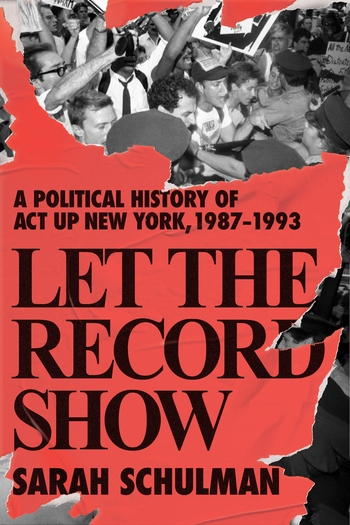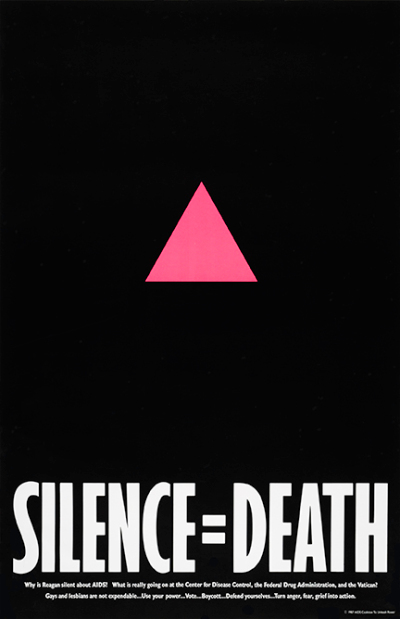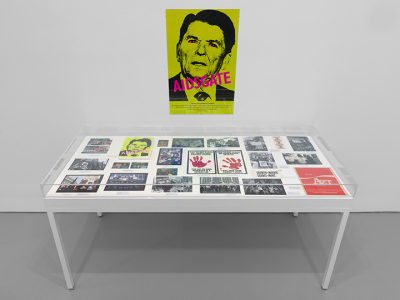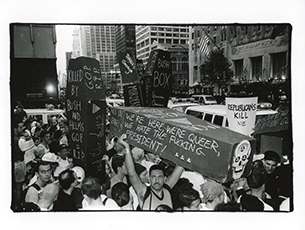 Gran Fury’s installation at the Venice Biennale, 1990. Courtesy Farrar, Straus and Giroux
Gran Fury’s installation at the Venice Biennale, 1990. Courtesy Farrar, Straus and Giroux  Let the Record Show: A Political History of ACT UP New York, 1987–1993 by Sarah Schulman, Farrar, Straus and Giroux, 2021; 736 pages, $40 hardcover.
Let the Record Show: A Political History of ACT UP New York, 1987–1993 by Sarah Schulman, Farrar, Straus and Giroux, 2021; 736 pages, $40 hardcover.
Sarah Schulman’s Let the Record Show: A Political History of ACT UP New York, 1987–1993 documents one of the most daring and important activist organizations in US history. It is meticulously, thoughtfully, and lovingly compiled. Schulman has dedicated much of her life to recording ACT UP’s impact. Her book Gentrification of the Mind (2012) detailed how AIDS changed the landscape of New York. The epidemic emptied whole neighborhoods, and the shifting social and economic tides washed away any awareness of the virus for the city’s new inhabitants. With filmmaker Jim Hubbard, Schulman is responsible for the ACT UP Oral History Project and United in Anger, a 2012 documentary about the group. Let the Record Show feels like the peak of her achievement, a standard for how this history should be presented. Focusing on the early years of ACT UP’s existence, the book is uniquely assembled, combining oral history, cultural analysis, and remembrances of those we’ve lost. With this structure, Schulman replicates the whirlwind of anger, grief, self-education, and political urgency that propelled ACT UP from a group of people who were fed up with the government’s ignorance, to a life-saving organization. “Art in the Service of Change,” book two in this 700-page work, makes an invaluable contribution to the history of activist art, bringing to life debates around strategies for graphics and actions.
A chapter on “The Artistic Life of Resistance” offers fascinating firsthand insights into the cohesion of ACT UP’s visual identity, such as the fact that the iconic pink triangle associated with the group was not the first idea for a logo. Some members contemplated depicting a tattooed butt, a cheeky response to William F. Buckley’s suggestion that people with AIDS be tattooed for easy identification—a frightening throwback to Nazi practices. Instead, they appropriated another reminder of the Holocaust—the inverted pink triangle sewn on the uniforms of imprisoned gay men—and turned it upright on a black background, above the slogan: SILENCE = DEATH.
 Silence = Death Project, Silence = Death, 1987. Courtesy the artist
Silence = Death Project, Silence = Death, 1987. Courtesy the artist
“Knowing that the poster would be wheat-pasted on the street implied a series of responsible considerations to create the maximum impact,” Schulman writes. The group pursued a striking minimalism, she adds, “to look slick, to appropriate the voice of authority.” The ACT UP affinity group Gran Fury was responsible for some of the most iconic AIDS-related visual artwork of the era. Members included Avram Finkelstein, Marlene McCarty, Tom Kalin, and a young filmmaker named Todd Haynes. One artist that Gran Fury took particular inspiration from was Barbara Kruger. “Marlene actually met Barbara Kruger, one of Gran Fury’s most fundamental influences,” Schulman recounts, “and Marlene told her, You know, we owed you a lot. And Kruger said, I know, but I’m glad you did it.” Gran Fury’s influence is still palpable, ironically perhaps most clearly felt within the cool look of modern editorials and advertising. That world has since digested this aesthetic, neutralizing its political potential.
ACT UP received many invitations to present their work at art institutions, and always worked to change the terms of display to ensure the work was in public space, not restricted to art audiences. The first such invitation came from the New Museum. Kalin constructed the large installation Let the Record Show, from which Schulman’s book takes its title, for the street-level window. Cutouts of Ronald Reagan and his conservative minions stood in front of a blown-up photograph of the Nuremberg trials. When approached by the Whitney Museum and the Venice Biennale, Gran Fury made billboards to be shown outdoors.
The artwork of ACT UP can currently be seen in Manhattan, albeit preserved behind panes of glass in a gallery. “More Life” at David Zwirner places ephemera from the Silence = Death collective in conversation with paintings by Derek Jarman, as well as Jarman’s elegiac film Blue (1993) and Marlon Riggs’s Tongues Untied (1989). Presented at the gallery are prototypes of the SILENCE = DEATH poster, photocopies of Finkelstein’s journal entries, sign-in sheets from ACT UP meetings, photos from protests, and numerous works by Gran Fury. Several of the photos displayed at the gallery appear in Let the Record Show. It’s quite a powerful experience to be able to see these artifacts in person, but even with Jarman’s narration faintly haunting the air, the space feels . . . well, silent. This is where Schulman’s book succeeds: it foregrounds the voices of the people in the movement. Let the Record Show is a sprawling encyclopedia on art and action, humming with so much vitality that the book practically breathes.
 View of the exhibition “More Life: Silence=Death” at David Zwirner, New York, 2021. Courtesy David Zwirner
View of the exhibition “More Life: Silence=Death” at David Zwirner, New York, 2021. Courtesy David Zwirner
On June 18, the Brooklyn microcinema Light Industry hosted its first in-person presentation in over a year. Schulman was there to introduce a screening of tapes referenced in Let the Record Show; they were made in the late eighties and early nineties by DIVA TV (Damned Interfering Video Activists), a media collective within ACT UP. “DIVA TV’s goals at the time it was founded was not festivals and certainly not TV broadcast,” Schulman explains in the book. “It was really for members of ACT UP to see a different perspective than they would have seen that night on television.” The group’s members pioneered tactics of activist media that have now become common. Schulman writes that George Plagianos, who was present at the screening, “started recording how the police were treating people with AIDS and AIDS activists when arresting them,” and that he was working “to try to make the police accountable and to protect our people from fabricated charges and unjust arrests.” She quotes Dean Lance, another ACT UP member, as saying: “When you have ten or fifteen people shouting a cop’s badge number into a rolling video camera they’re less likely to deprive you of your civil rights or your brains.”
The tapes screened at Light Industry, Target City Hall, Pride, and Like a Prayer, document some of ACT UP’s most well-known demonstrations—the FDA takeover of 1988, the die-in at St. Patrick’s Cathedral in 1989. For all the seriousness of the group’s aims, their methods showed a sense of humor. Laughter was not just a coping mechanism, but an activist technique. Watching Pride, I was surprised and amused to see crowds chucking styrofoam bricks in the air, bouncing them around as if at a music festival. The mood felt much more jubilant than the corporatized, over-policed Pride parades of today. In Like a Prayer, activists dressed up in clown costumes and parroted anti-abortion rhetoric, highlighting the church’s ludicrous fanaticism. ACT UP member Ray Navarro, dressed as Jesus Christ, dispensed tips for safe sex.
 ACT UP at the Waldorf Astoria, New York, 1990. Courtesy Farrar, Straus and Giroux
ACT UP at the Waldorf Astoria, New York, 1990. Courtesy Farrar, Straus and Giroux
There was a lot of laughter from the audience, but the anger was still present, too. After the screening, Plagianos and Robert Buck, another member of DIVA TV, came to the front to answer questions. Buck expressed gratitude that we had seemingly found our way out of the Covid-19 pandemic—that more sensible leadership and the vaccine program had prevailed. Things were wrapping up and we applauded the queer elders, when Plagianos silenced our claps. “Wait!” he snapped. “Health care is still a fucking mess in this country!” The crowd, as if coming to its senses, responded with an immediate, indignant agreement. “I mean, what are we going to do? Who are we going to choose?” he said, referring to the city’s dismal mayoral primary race. Gauze hugged his skinny leg. Suddenly, it felt as if we were at an ACT UP meeting rather than a screening. Before shuffling out into the Brooklyn night, we chanted together, “ACT UP! Fight back! Fight AIDS!”
Schulman reminds us in the book’s opening pages that “AIDS is not over. Out of the 100,000 New Yorkers who have died of AIDS, 1,779 died in 2017. . . . ACT UP New York still exists.” The struggle continues. Schulman’s book is a foundational building block in telling the story of AIDS, but that story is still unfolding. Let the Record Show is something to study and wield as we combat yet another plague. It is a brick to be thrown.
Source link : https://www.artnews.com/art-in-america/aia-reviews/sarah-schulman-let-the-record-show-act-up-1234600351












